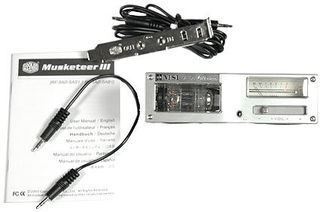MSI K8N Diamond Plus
Hear, Hear: Sound Blaster Audigy SE On-Board

As the box already points out, what we are looking at here is the "HiFi Edition" of this board. The name is not simply another marketing phrase either: the K8N Diamond Plus sports a Sound Blaster Audigy SE. This is definitely more than just a step up from the usual AC97 sound systems found on most boards. This chip induces a far lower processor load, and features a signal-to-noise ratio of 100 dB(A) - an important factor when high-quality audio components are used. Features like 7.1 channels, 24-bit sound and a 96 kHz sampling rate, on the other hand, have become standard for high-definition audio solutions. Gamers will also benefit from the chip's support for EAX 3.0, which is often used for in-game sound effects.
The Audigy SE is not the most recent model, however, and in addition to the high-end Audigy 4, Creative is also selling the Audigy 2 ZE. That chip's impressive feature list includes EAX 4.0, Dolby Digital EX, 192 kHz, and full DTS and THX certification. So while there is theoretically still room for improvement, this would drive up the price unnecessarily without any real benefit to the buyer.
Sound System With A Tube Amp (Tube Panel)

The included tube amp made by Coolermaster is a nice gimmick. Its 5.25" form factor allows it to be mounted in a free drive bay, letting users connect any analog audio component, such as headphones, to it on the front of the case. The classic round dB gauge is a nice touch; sadly, it is so far back in the module that it is practically impossible to see when looking at it from above at an angle.
Our picture requires a little explanation. The tube itself does not glow; the light comes from an LED instead. While it could be argued that this is not "authentic", it is nonetheless a very nice aesthetic touch.
On another note, we can't quite follow MSI's criticism of AOpen's take on the same idea. MSI claims that integrating the tube-based amplifier directly on the mainboard, as AOpen's designs do, brings an increased risk of localized overheating, results in loss of valuable space because of the tubes and offers only added value when combined with a conventional AC97 codec. Also, the tubes are only visible in cases with windows. However, MSI is shooting itself in the foot with that line of argumentation. In its own design, the amplifier is attached to the sound card's analog output, which in itself represents a possible degradation in signal quality.
In the end, the feature is more of a gimmick than anything, and most likely not a factor that will sway buyers in its favor. As such, it doesn't impact our final verdict one way or another.


Stay on the Cutting Edge
Join the experts who read Tom's Hardware for the inside track on enthusiast PC tech news — and have for over 25 years. We'll send breaking news and in-depth reviews of CPUs, GPUs, AI, maker hardware and more straight to your inbox.
Current page: Hear, Hear: Sound Blaster Audigy SE On-Board
Prev Page Overclocking: Reaching 300 Next Page Test SetupMost Popular

